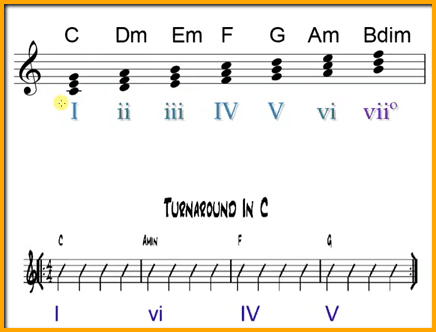If you are looking for an interesting music theory explained in a fun simple way, I will attempt to explain the roman numeral system theory in the present article.
What Is The Roman Numeral System?
The roman numeral system theory is basically a music system that refers to chord sequences and music patterns. Although it seems, at first, that the whole system is complicated and hard to understand, it is relatively simple once you know some basic music concepts.
The roman numeral system theory is based on the idea that a specific chord sequence is included in a key (tonic note/chord). For example, a musical composition named “X” may belong in the “C” key position while another may belong to “G” key. Similarly, there is a scale that is linked with each key. For example, a song that belongs in the “C” key resembles the “C” scale, a “G” key song is linked with the “G” scale etc.
How It Related To The Musical Scale
Each scale consists of 7 notes each resembled with the 7 first letters of the alphabet: A, B, C, D, E, F, G (the rest 19 like H, I or O are not included). After the G note/letter the pattern is repeated in order to ensure the sequence consists of 7 notes. For an instance, if a scale starts from the letter B it will have this pattern: B, C, D, E, F, G, A whereas if it starts with an F, it will be: F, G, A, B, C, D, E and so forth. As we notice here, the pattern ends with G and starts again with the letter A and the following letters until we get 7 notes consecutively.
Understanding Uppercase And Lowercase
In musical roman numerical system, each noted is represented with a roman numerical not in alphabetical order but following the sequence. If we take the above pattern ( F, G, A, B, C, D, E) it will be represented like that:
Major chords are represented with upper case numerals like I or V, minor chords are represented by lowercase numerals like i and v for example.

1.) F, which is the first note that starts the pattern, will be represented as “1” or “I” roman numeral.
2.) Gm, the second note, will be represented as “2” or “ii”
3.) Am, the third note, will be represented as “3” or “iii”
4.) Bb, the fourth note, will be represented as “4” or “IV”
5.) C, the fifth note, will be represented as “5” or “V
6.) Dm, the sixth note, will be represented as “6” or “vi”
7.) E dim, the seventh note, will be represented as “7” or “vii dim (I don't know how to create that small 0 you'll see in the video)”
Let’s say that we have the following chord progression: I – vi– IV – V or 1 – 6 – 4 – 5 in plain numbers. In this case, it would become F, Dm, Bb, C in the key of F. Some variations of the plain F key are the F# or F sharp.
Here is also another example with a key of G with both minor and major numerals:
1. G or I
2. Am or ii
3. Bm or iii
4. C or IV
5. D or V
6. Em or vi
7. F# dim or vii (dim)
In this case, the I – vi – IV – V chord progression in the key of G (the first note) is G – Em (minor) – C – D.
Now, that you know the basics of the roman numeral system you have a foundation for further understanding how chord progressions are notated and talked about.

Really good. Thanks a lot.
Hi Ta Duy,
You are most welcome.
May you have a great time playing guitar.
Thanks,
Hazel
Starland Guitar
Customer Support